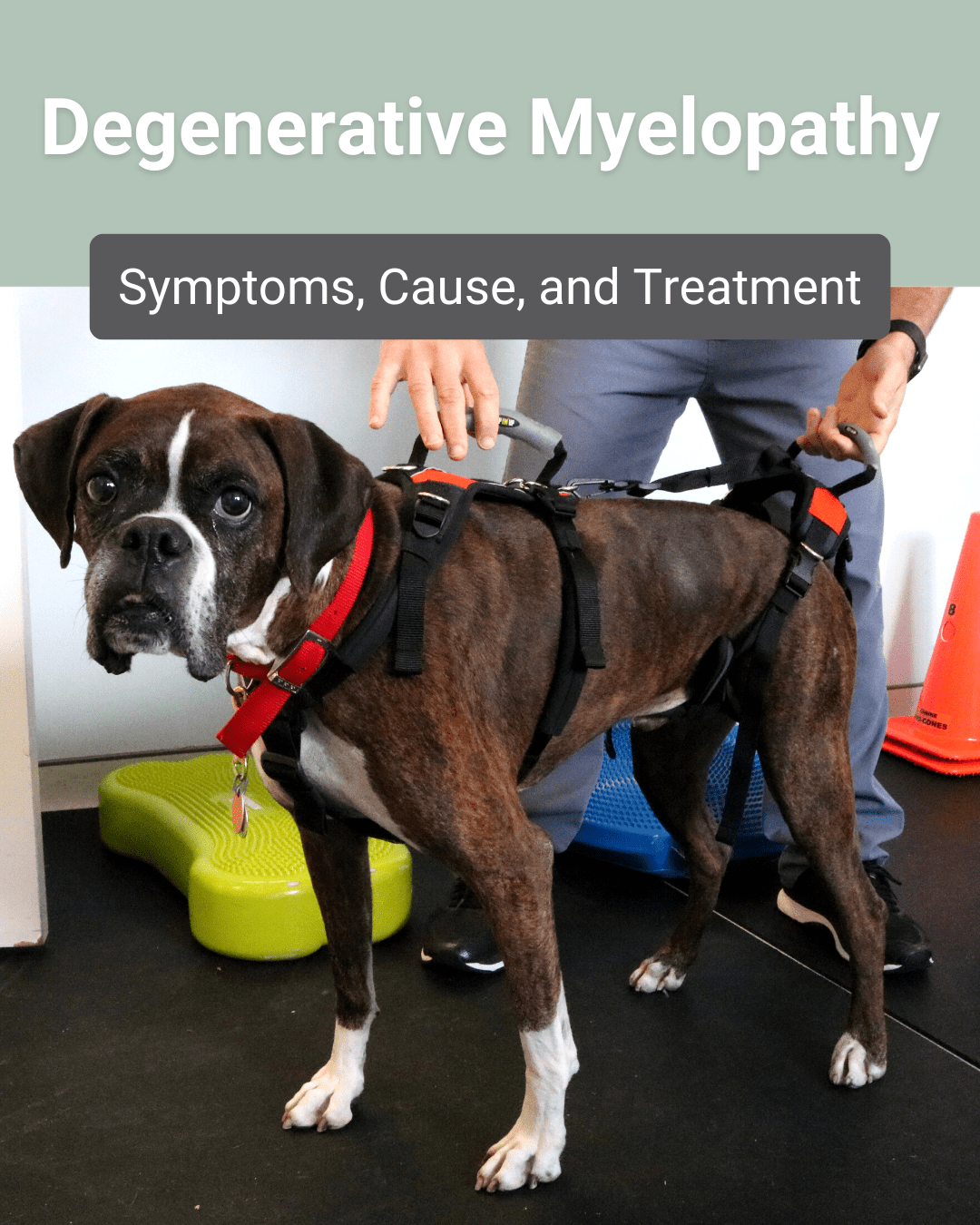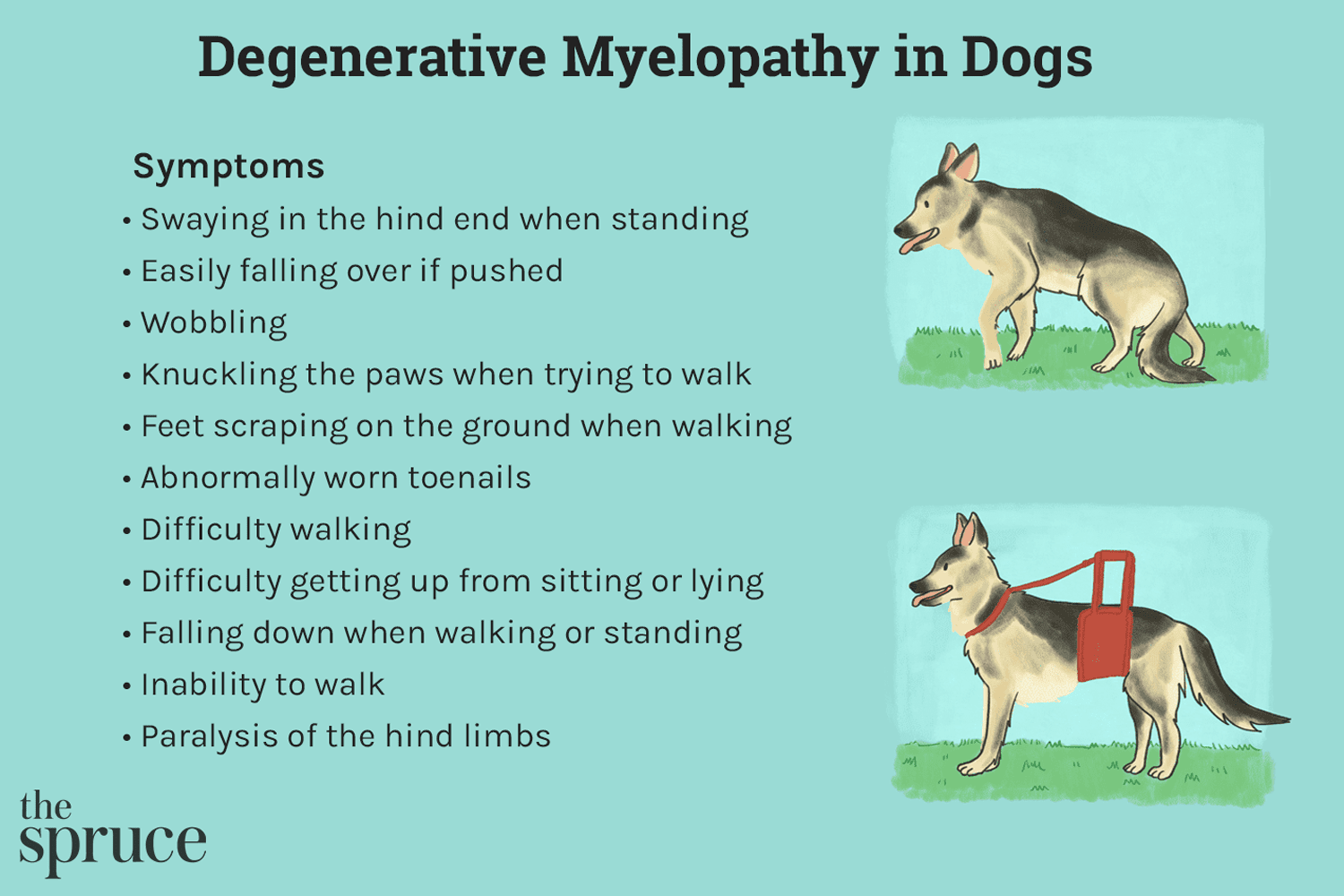When to put down a dog with degenerative myelopathy: Euthanasia is usually considered within six months to three years after the dog enters the final stages of the disease. During this time, the dog may experience a loss of mobility and suffer from an inability to walk or breathe normally.
In-home euthanasia can provide a compassionate farewell to your furry friend and end its suffering.

Credit: sevneurology.com
Overview Of Degenerative Myelopathy
Once your dog enters the final stages of degenerative myelopathy, it may be time to consider euthanasia within the next six months to three years. While there is no cure for this condition, you can provide a compassionate farewell to your furry friend through in-home euthanasia to end its suffering.
Introduction
Degenerative Myelopathy is a progressive disease that affects the spinal cord of dogs, particularly those in the older age group. This degenerative condition is unfortunately incurable, and it causes a gradual loss of coordination and mobility, ultimately leading to paralysis. The condition is often compared to ALS (amyotrophic lateral sclerosis or Lou Gehrig’s disease) in humans. Understanding the overview of degenerative myelopathy is crucial for dog owners to comprehend the gravity of the disease and make informed decisions regarding their pet’s well-being.
Causes
The exact cause of degenerative myelopathy is not yet fully understood, but it is believed to have a genetic component, particularly in certain breeds such as German Shepherds, Boxers, and Corgis. It is thought to result from a mutation in the SOD1 gene, which is associated with oxidative stress. Other factors such as age and immune system dysfunction may also play a role in the development and progression of the disease.
Clinical Signs
Common clinical signs of degenerative myelopathy include hind limb weakness, difficulty walking, dragging of the paws, and loss of muscle mass in the hind limbs. As the disease progresses, dogs may experience urinary and fecal incontinence as well as paralysis in the hind limbs. The disease typically does not cause pain, and affected dogs generally maintain normal behavior and appetite despite the physical limitations.
Diagnosis
Diagnosing degenerative myelopathy involves ruling out other possible causes of the symptoms, such as disc disease or spinal cord tumors. A definitive diagnosis can be made through a combination of physical examination, neurological testing, and advanced diagnostic imaging techniques, such as MRI or CT scans. Additionally, genetic testing for the SOD1 mutation can be conducted in susceptible breeds to identify predisposition to the disease.
Treatment
Unfortunately, there is no cure for degenerative myelopathy, and treatment options aim to support the dog’s quality of life and manage the progression of the disease. This may involve physical therapy, assistive devices like harnesses and wheelchairs, and modifications to the dog’s environment to help with mobility. Additionally, pain management and incontinence management may be integrated into the treatment plan to ensure the dog’s comfort and well-being.

Credit: www.walkinpets.com
Signs It’s Time To Euthanize
To put down a dog with degenerative myelopathy, consider when the final stages set in, usually within six months to three years. In-home euthanasia can offer a compassionate farewell to end your furry friend’s suffering. Listen for signs of poor quality of life like withdrawal or restlessness to know when it’s time.
Understanding Quality Of Life
Recognizing the right time to euthanize a beloved pet suffering from degenerative myelopathy is a challenging decision for any pet owner. As a responsible and caring pet parent, it’s essential to carefully assess your dog’s quality of life, focusing on their comfort, happiness, and ability to perform daily activities. Quality of life can be measured by observing your dog’s behavior, appetite, mobility, and overall well-being. When your dog’s condition no longer allows them to enjoy life or if they are in constant discomfort, it may be the most humane decision to consider euthanasia.
Visible Signs Of Discomfort
It’s crucial to monitor your dog for any visible signs of discomfort or distress. Watch for changes in their behavior, such as increased restlessness, difficulty in getting comfortable, or unusual lying positions. Dogs with degenerative myelopathy may also exhibit withdrawal from physical contact, reduced interest in activities they once enjoyed, and severe mobility issues. These visible signs can indicate that your dog is no longer living a comfortable and happy life, raising the question of euthanasia as a compassionate option.
Managing Degenerative Myelopathy
When a dog reaches the final stages of degenerative myelopathy, it may be time for euthanasia within six months to three years. Although there is no cure for this condition, providing a loving farewell through in-home euthanasia can end the suffering and offer comfort to your furry friend.
Comfort Measures
Ensuring your dog with degenerative myelopathy is comfortable is paramount. Common signs of pain and discomfort include restlessness and avoidance of physical contact.
- Provide a cozy and quiet space
- Regularly check for pressure sores
- Implement pain management strategies
Rear-end Support
Your furry friend may struggle with mobility as the disease progresses. Rear-end support is crucial for helping your dog navigate day-to-day activities.
- Consider using a support sling for stairs and smooth floors
- Utilize a full-body harness with front and rear handles for better support
- Consult with a veterinarian for tailored support solutions
Financial And Emotional Factors
Having a dog with degenerative myelopathy can bring financial and emotional challenges. When deciding on euthanasia, consider the cost of care alongside your pet’s quality of life. Supporting your dog through the stages with comfort measures can provide a loving farewell, easing its suffering at home.
Financial Considerations
When faced with the decision of when to put down a dog with degenerative myelopathy, it is essential to consider both the financial and emotional factors involved. Caring for a dog with this progressive disease can be financially demanding, as the cost of medication, veterinary consultations, mobility aids, and specialized care can quickly add up. It is crucial to assess your financial situation and determine if you can afford the ongoing expenses associated with caring for a dog with degenerative myelopathy.
As a pet owner, saying goodbye to a beloved companion can be an incredibly emotional experience. Creating a farewell ceremony can provide closure and help you cope with the loss. Consider setting aside a special place to hold the ceremony, whether it be in your backyard or a serene outdoor location. You can invite close friends and family members who have been supportive throughout your dog’s journey. Make the ceremony personal by sharing memories, reading poems or heartfelt messages, and even creating a small memorial for your dog.
Euthanasia In Degenerative Myelopathy
Degenerative Myelopathy is a progressive and debilitating disease that affects many dogs. As pet owners, it can be heart-wrenching to witness our beloved furry friends struggle with mobility and suffer. Understanding when to consider euthanasia for a dog with Degenerative Myelopathy is an important decision that requires careful consideration.
Timing Of Euthanasia
Once your dog reaches the final stages of Degenerative Myelopathy, it is crucial to be prepared for the possibility of euthanasia within the next six months to three years. While there is currently no cure for this condition, you have the option to provide your pet with a compassionate farewell through in-home euthanasia.
In-home Euthanasia
In-home euthanasia offers a peaceful and comfortable environment for your dog’s final moments. By opting for this compassionate approach, you can eliminate the stress and anxiety that often comes with visiting a veterinary clinic. In-home euthanasia allows your beloved pet to be surrounded by familiar surroundings, minimizing any anxiety they may experience.
During the process of in-home euthanasia, a qualified veterinarian will administer medication that will peacefully and painlessly end your pet’s suffering. You can also choose to be present during this final moment, providing comfort and reassurance to your furry friend.
When considering in-home euthanasia, it is essential to find a reputable veterinarian who specializes in this service. They can guide you through the process, answer any questions or concerns you may have, and ensure a respectful and compassionate experience for both you and your dog.
Overall, euthanasia is a difficult but compassionate decision to make for a dog with Degenerative Myelopathy. By considering the timing of euthanasia and exploring the option of in-home euthanasia, you can provide your pet with a peaceful farewell, free from pain and suffering.

Credit: pawsintograce.com
Coping With Loss
When your dog with degenerative myelopathy enters the final stages of the disease, it may be time to consider euthanasia. While there is no cure, you can provide a compassionate farewell by ending their suffering through in-home euthanasia.
Dealing With Grief
Coming to terms with the loss of a beloved pet can be overwhelming and emotional.
Memorializing Your Pet
Creating a tribute or memorial for your furry friend can help in the grieving process.
Professional Guidance And Support
Professional Guidance and Support are crucial aspects to consider when determining when to put down a dog with degenerative myelopathy. It is a difficult decision for any pet owner to make, and seeking guidance from professionals and emotional support from loved ones can provide the necessary assistance during this challenging time.
Consulting With Veterinarians
Consulting with a veterinarian is essential when evaluating your dog’s quality of life and considering euthanasia as an option. Veterinarians can assess the progression of the disease and provide valuable insight into your pet’s condition. They can help you understand the physical and emotional implications of degenerative myelopathy and offer guidance on making the best decision for your dog’s well-being.
Seeking Emotional Support
Seeking emotional support from family, friends, or support groups can alleviate the emotional distress associated with this decision. Sharing your feelings and anxieties with a supportive network can provide comfort and understanding during this emotional journey. It’s essential to prioritize your emotional well-being while navigating the difficult path of euthanasia for your beloved pet.
Community Resources And Forums
When facing the difficult decision of when to put down a dog with degenerative myelopathy, it’s essential to seek support and guidance from others who have experienced similar situations. Community resources and forums can provide valuable insights, emotional support, and practical advice to help navigate this challenging journey.
Online Platforms For Support
Online platforms offer a wealth of information and connections for caregivers of dogs with degenerative myelopathy. Engaging in these platforms can help in gaining a sense of community and understanding from like-minded individuals.
- Facebook groups dedicated to degenerative myelopathy support
- Specialized forums for sharing experiences and seeking advice
- Online support networks and chat rooms
Sharing Experiences
Sharing experiences can be therapeutic and enlightening for those dealing with the complexities of managing degenerative myelopathy in their beloved pets. Engaging in discussions with others who have gone through similar struggles can provide a sense of comfort and understanding.
- Personal blogs and diaries documenting the journey of caring for a dog with degenerative myelopathy
- Online platforms for sharing stories and exchanging practical tips
- Virtual support groups for open dialogue and emotional support
Frequently Asked Questions
At What Point Do You Euthanize A Dog With Degenerative Myelopathy?
Prepare for euthanasia when your dog reaches the final stages of degenerative myelopathy, typically six months to three years post-diagnosis. This condition has no cure, so consider in-home euthanasia as a compassionate farewell to alleviate your furry friend’s suffering.
What Is The Final Stage Of Dm In Dogs?
The final stages of Degenerative Myelopathy in dogs may lead to the possibility of euthanasia within six months to three years. This condition has no cure, but in-home euthanasia can end your pet’s suffering and provide a loving farewell.
How Do I Make My Dog With Degenerative Myelopathy Comfortable?
To make your dog with degenerative myelopathy comfortable, use a rear-end support harness for assistance with walking and make adjustments to your home to prevent slips and falls. Additionally, provide a warm and cozy environment to help ease any discomfort your dog may experience.
How Do I Know It’s Time To Euthanize My Dog?
If your dog shows signs of pain, discomfort, withdrawal, or restlessness, and quality of life has deteriorated, it may be time to consider euthanasia.
Conclusion
When your dog reaches the final stages of degenerative myelopathy, euthanasia can provide a compassionate release from suffering. Though there’s no cure, the loving act of in-home euthanasia offers a peaceful farewell. Take comfort in knowing you can end your furry friend’s pain with dignity.



